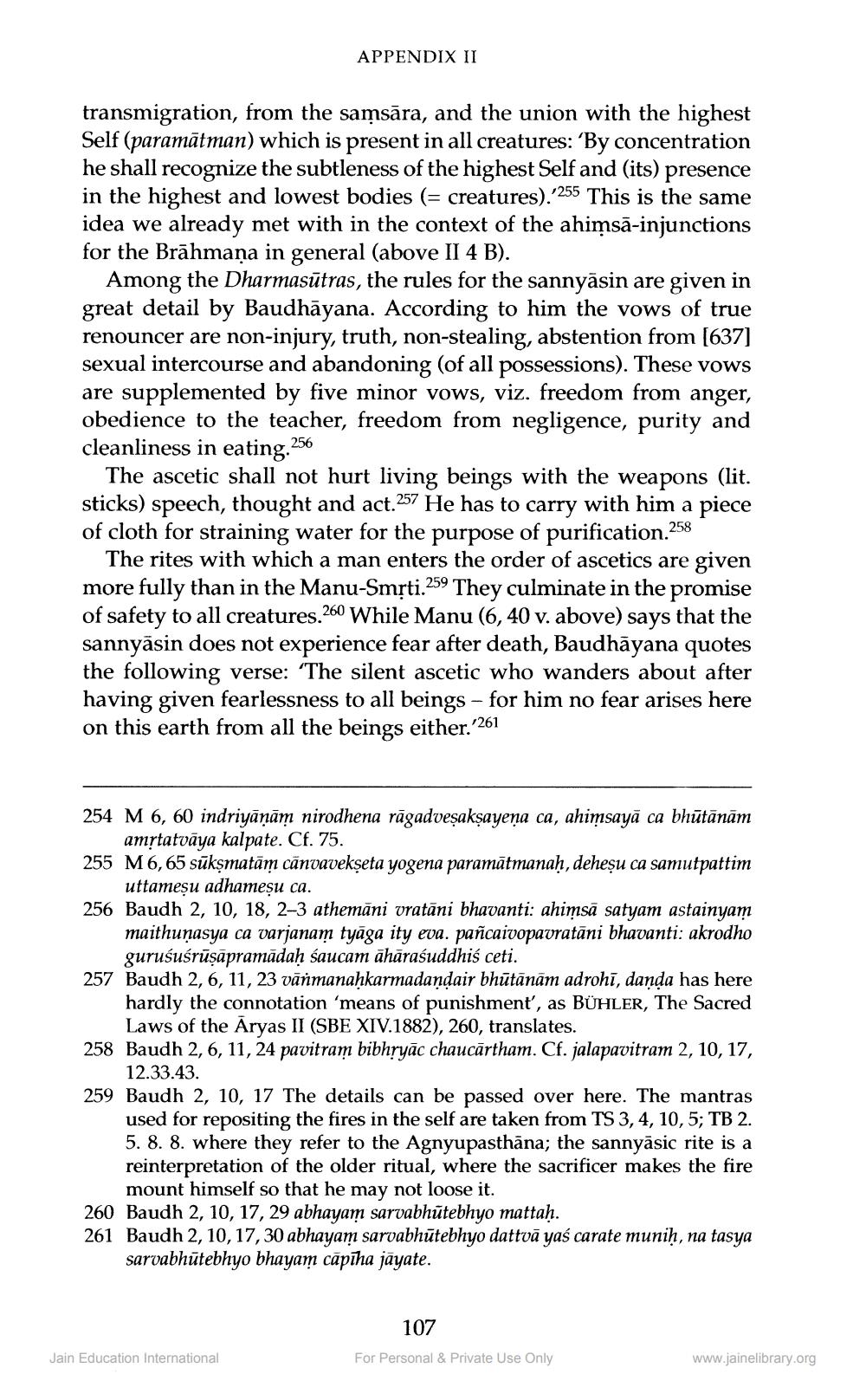________________
APPENDIX II
transmigration, from the samsāra, and the union with the highest Self (paramātman) which is present in all creatures: ‘By concentration he shall recognize the subtleness of the highest Self and (its) presence in the highest and lowest bodies (= creatures). 255 This is the same idea we already met with in the context of the ahimsā-injunctions for the Brāhmaṇa in general (above II 4 B).
Among the Dharmasūtras, the rules for the sannyāsin are given in great detail by Baudhāyana. According to him the vows of true renouncer are non-injury, truth, non-stealing, abstention from (637) sexual intercourse and abandoning (of all possessions). These vows are supplemented by five minor vows, viz. freedom from anger, obedience to the teacher, freedom from negligence, purity and cleanliness in eating.256
The ascetic shall not hurt living beings with the weapons (lit. sticks) speech, thought and act.257 He has to carry with him a piece of cloth for straining water for the purpose of purification.258
The rites with which a man enters the order of ascetics are given more fully than in the Manu-Smrti.259 They culminate in the promise of safety to all creatures.260 While Manu (6,40 v. above) says that the sannyāsin does not experience fear after death, Baudhāyana quotes the following verse: 'The silent ascetic who wanders about after having given fearlessness to all beings - for him no fear arises here on this earth from all the beings either.'261
254 M 6, 60 indriyāņām nirodhena rāgadveşakşayena ca, ahimsayā ca bhūtānām
amrtatvāya kalpate. Cf. 75. 255 M6,65 sūksmatām canvavekseta yogena paramātmanaḥ, deheșu ca samutpattim
uttamesu adhamesu ca. 256 Baudh 2, 10, 18, 2-3 athemāni vratāni bhavanti: ahimsā satyam astainyam
maithuņasya ca varjanam tyāga ity eva. pañcaivopavratāni bhavanti: akrodho
guruśusrūsāpramādaḥ saucam āhārasuddhis ceti. 257 Baudh 2, 6, 11, 23 vānmanahkarmadandair bhūtānām adrohi, danda has here
hardly the connotation 'means of punishment', as BÜHLER, The Sacred
Laws of the Aryas II (SBE XIV.1882), 260, translates. 258 Baudh 2, 6, 11, 24 pavitram bibhryāc chaucārtham. Cf. jalapavitram 2, 10, 17,
12.33.43. 259 Baudh 2, 10, 17 The details can be passed over here. The mantras
used for repositing the fires in the self are taken from TS 3, 4, 10,5; TB 2. 5. 8. 8. where they refer to the Agnyupasthāna; the sannyāsic rite is a reinterpretation of the older ritual, where the sacrificer makes the fire
mount himself so that he may not loose it. 260 Baudh 2, 10, 17, 29 abhayam sarvabhūtebhyo mattaḥ. 261 Baudh 2, 10, 17,30 abhayam sarvabhūtebhyo dattvā yaś carate munih, na tasya
sarvabhūtebhyo bhayam cāpīha jayate.
107 For Personal & Private Use Only
Jain Education International
www.jainelibrary.org




